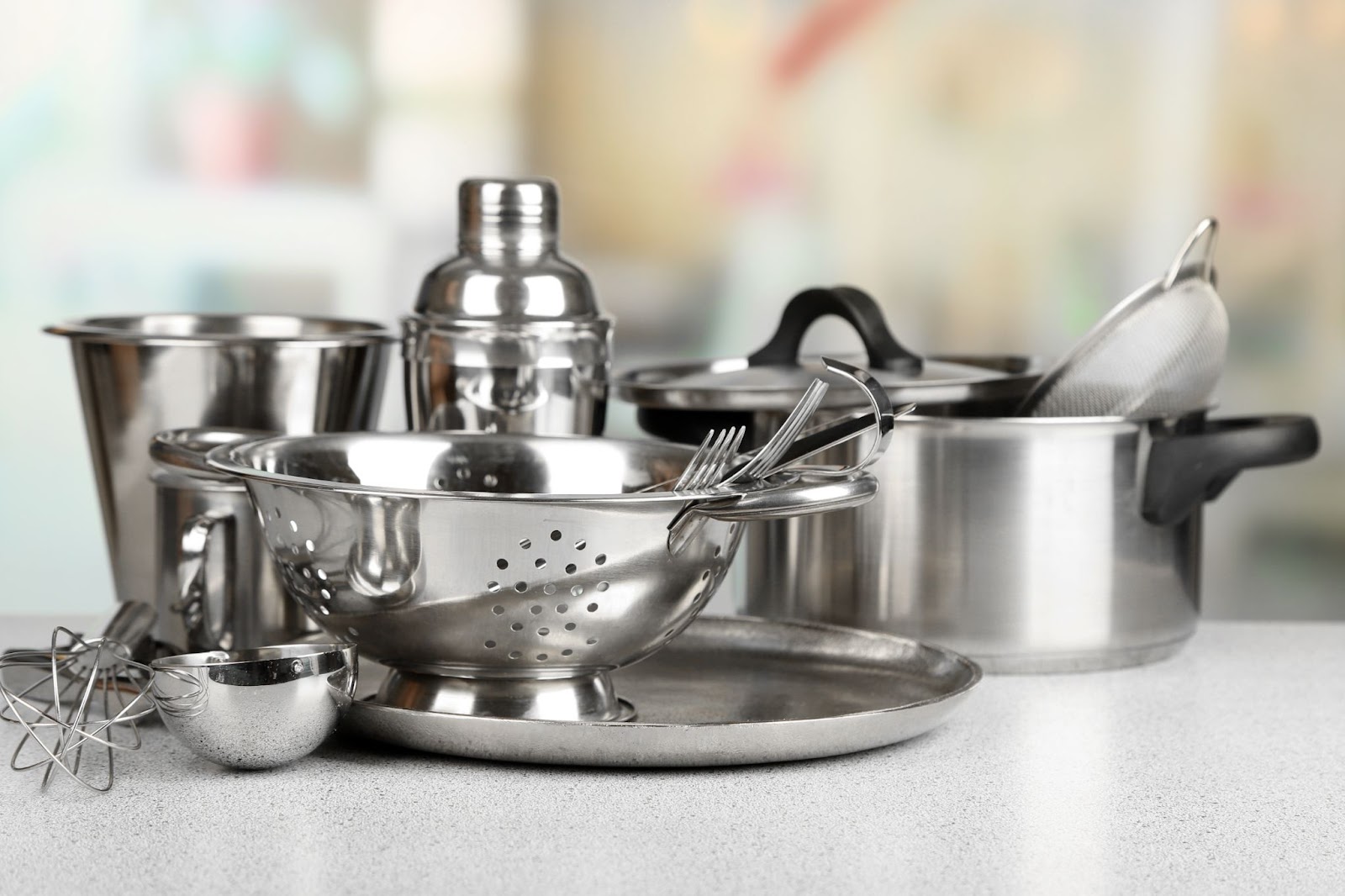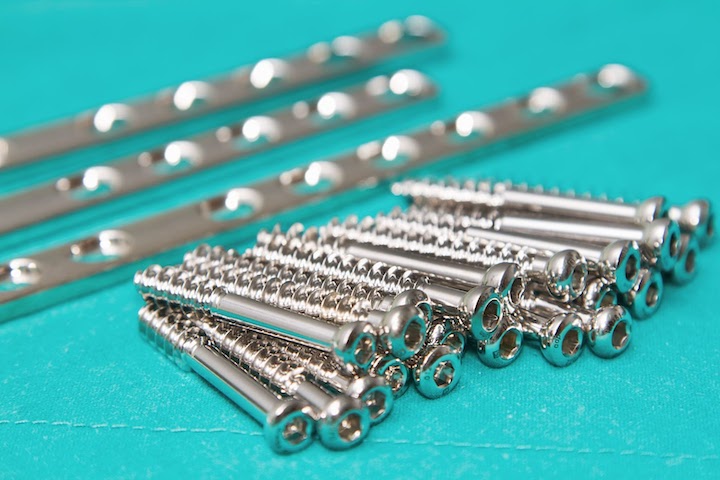Time to read: 7 min
Stainless steel, a corrosion-resistant iron-chromium alloy, is one of the most common and versatile metal alloys in the world. It’s strong, environmentally resilient, visually appealing, affordable, and has properties that are hard to come by in other metals. It is a green material due to its near-infinite recyclability. From the surface of the latest kitchen appliance, to a structural beam in a building, to surgical instruments in an operating room, stainless steel is all around us. Wonder what makes stainless steel stainless? Read on to learn the secrets of this versatile material, including the origin of its name.

Modern Stainless Steels and Their Uses
What we now call stainless steel comes in four families which broadly refer to their microscopic crystalline structure and their varying metallurgical phases:
- Austenitic steels: austenite phase stainless steel is comprised of nickel and molybdenum as its main alloying elements, and has a face-centered cubic crystal structure. The addition of nickel increases its corrosion resistance and ductility, while molybdenum improves corrosion resistance to acidic conditions. Common grades of austenitic stainless steel are 304 and 316.
Common uses: this type of stainless steel is considered heat resistant and is commonly utilized to produce heat exchangers, boilers, and furnaces. Other common applications of austenitic stainless steel are aerospace components, electronics, locomotive parts, and chemical tanks. 200 series stainless steels are also in the austenitic family, but have manganese as an additional alloying element.
- Martensitic steels: the martensite phase stainless steel family uses carbon and chromium as its main alloying elements. At higher carbon concentrations, the material has a body-centered tetragonal crystal structure; lower carbon concentrations form a body-centered crystal structure. Martensite is formed when austenite is quenched rapidly at room temperature. Martensitic stainless steel is commonly known as 400 series of stainless steel, such as grades 410, 420, and 440.
Common uses: martensitic stainless steel is commonly utilized in applications where hardness and durability are desired, such as cutlery, tooling, turbine blades, fasteners, and gears.
- Ferritic steels: ferrite phase stainless steel is non-magnetic and has a body-centered cubic crystal structure. Its main alloying constituents are chromium, iron (hence the name ferritic), and a low concentration of carbon. Ferritic stainless steel is therefore softer, but also has increased ductility and improved formability — but they cannot be heat treated. Examples of ferritic stainless steel are other 400 series grades, such as 409, 430, and 446.
Common uses: ferritic stainless steels are a common choice for kitchenware, automotive components, and industrial machinery.
- Duplex steels: duplex stainless steel is a mixture of austenite and ferrite steel.
Common uses: duplex steels are often used in the oil and gas, paper, and chemical industries.
The Origins of Stainless Steel: Groundwork in the 1800s
The history of stainless steel is riddled with scandal, similar to the story of my favorite scientist, Nikola Tesla and his rival Thomas Edison. Like their electrifying story (pun intended), stainless steel came from several men taking credit for another man’s work. There are whole countries who, to this day dispute who is the “inventor” of stainless steel.
While some contend that stainless steel was utilized by blacksmiths in ancient India, Sri Lanka, the Arabian peninsula, and China before the Industrial Revolution, those histories weren’t well recorded. What we do know is that in the early 1800s, scientists in several countries observed a phenomenon with metal alloys containing chromium and iron — they were able to resist acid corrosion.
A French metallurgist, Pierre Berthier, is credited as the first to recognize in 1821 that a corrosion-resistant steel alloy could be made by adding chromium to iron. While metallurgists drew this conclusion, they didn’t yet know the importance of limiting carbon content in those same alloys to prevent intergranular corrosion and fracturing due to brittleness. But, they were off to a good start by gleaning how chromium altered the physical properties of a metal alloy.
In England in 1872, John Clark and John Woods filed the first official patent for what we now consider stainless steel. They called their product a Water Resistant Alloy and it was remarkably similar to modern alloys, but the material still had too much carbon.
The first to officially recognize the carbon issue was a researcher simply known as Brustlein in 1875. His revelation sparked several decades of research to develop the optimal mixture of metals and a production method for developing low-carbon steel. While we have modern processes for creating metal alloys today, the science back then was rudimentary. Finding a way to separate chromium from the carbon it was naturally found with was the main obstacle to producing chromium-based, low-carbon steel.
About two decades after Brustlein’s low carbon epiphany, in 1895 Hans Goldschmidt developed the aluminothermic reaction process for producing/refining chromium to be carbon-free. This was the turning point that enabled the development of modern stainless steel. The chemical reaction for what is also known as the aluminum reduction method for producing chromium metal is shown below.
Cr2O3 + 2Al → 2Cr + Al2O3
Aluminum Reduction Method for Chromium Production
It’s a process where chromium oxide (and any impurities naturally found with it like silicon, sulphur or carbon) and aluminum are added to a steel container lined with either an organic binder, alumina, or magnesium oxide, and heat. The mixture is ignited with barium peroxide to creat an exothermic reaction — meaning there is a net release of energy (heat) when the chromium and resulting slag are produced.
Today, this process is still used to produce both ‘pure’ chromium and aluminum oxide for various post-processing applications. The constituent concentrations for the chemical reaction can be modified to produce different purity levels of the resulting metals.
Stainless Steel Advancements in the 1900s
The early 1900s brought about several important discoveries in the advancement of the stainless steel alloy family:
– In 1904 Leon Guilet discovered several 400 series, iron-chromium stainless steel alloys and researched the 300 series, iron-nickel-chromium alloys — though he didn’t realize that the metals were corrosion-resistant.
– P. Monnartz and W. Brochure discovered that adding chromium to the metal alloy increased its corrosion resistance, and quantified the minimum chromium concentration as 10.5%. They also worked on detailing and researching the increased corrosion resistance that comes with the addition of molybdenum.
Why We Call it Stainless Steel
The next major advancement occurred in 1913 when Harry Brearley is reputed to have officially discovered stainless steel in an attempt to create erosion-resistant steel. Now, Harry Brearly is probably the correct answer to trivia question about who invented stainless steel, but the the truth isn’t that straightforward. He experimented with adding chromium to steel, but the rest of his story is laced in myth.
Some say that Brearly threw his experimental metal alloy in the trash, only to pull it out later and realize the steel didn’t stain or didn’t rust. Others claim that he had to etch his sample with nitric acid to microscopically examine it, but he found that the metal didn’t rust when exposed to nitric and other acids or reducing agents. Harry saw the potential of his alloy to be used for knife blades, but he wasn’t supported by his employers, and he couldn’t get the alloy to resist rusting or staining for long periods of time.
So, in steps his friend Ernest Stuart, who found that hardening the knife blades improved their rust and stain resistance. Brearly wanted to call the material “Rustless Steel,” but Stuart named it “Stainless Steel” because of its ability to resist staining after being exposed to a vinegar solution.
Also, while Brearly lays claim to the discovery of stainless steel, others are touted to have discovered it before him, including:
- In 1908, Kupp Iron Works developed a chromium-nickel alloy for a marine application.
- In 1911, Elwood Haynes created a corrosion-resistant steel to replace his rusty razor blades.
- From 1911-1914, Becket and Dantsizen created a few ferritic steel alloys.
- In 1912, Max Mauermann claimed to have created stainless steel, but he likely only created a viable production method for stainless steel. He filed a patent for the process, but it was disputed at the time, and he wasn’t recognized as an inventor of stainless steel until after his death.
The rich history of stainless steel and the development of the various grades of the material is owed to the efforts of many scientists, researchers, metallurgists, and engineers. Over the last century plus, the types of stainless steel, production methods, and recycling methods have all improved. We now can fully harness and monopolize the natural phenomena of stainless steel oxidation.

From its controversial beginnings to its highly sophisticated and metallurgically interesting present, stainless steel is a incredibly versatile and robust metal suitable for even your most complex projects.
Sourcing Simplified – Start Your Next Project With Fictiv
For all your stainless steel manufacturing and finishing needs, Fictiv has you covered. We’re experts at producing custom CNC machined stainless steel parts, in a variety of materials, and we simplify custom part sourcing with intelligent, streamlined, automated workflows. Fictiv is your operating system for custom manufacturing that makes part procurement faster, easier, and more efficient.
Create an account and upload your part to see what our instant online CNC quote process, design for manufacturability feedback, and intelligent platform can do for you. We can deliver your CNC machined parts in as fast as 2 days!










